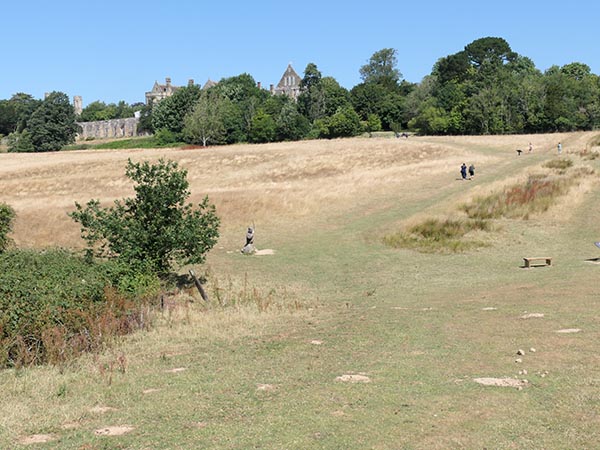This past July, I visited the location of the Battle of Hastings and the ruins of Battle Abbey, which is managed by English Heritage. It was one of the scorching days of the year with sunshine, and we arrived early in the morning before it was too humid. Because of the hot weather, we decided to walk the battlefield walk first and then finish off at the top of the hill at the ruins of Battle abbey. I recommend the audio tour guide, which makes the battlefield and abbey tours come alive with the information.

We looked around a museum underneath the cafe that contained more information about the infamous Battle of Hastings and the characters involved. In short, King Edward the Confessor was the king of England, but he died without an heir. Harold was the King Edward the Confessor's wife's brother. Harold had claimed that Edward promised him the throne on his deathbed, so he was crowned the following day. However, William of Normandy (who would come to be known as William the Conqueror) disputed this and said that the crown of England was promised to him.

A few days before the infamous battle, King Harold's army were in the north at Stamford Bridge to defend against attacks from Norway. Norway wanted to place Harold's brother Tostig on the throne. England won the battle, but there was a long march back down south to defend the south coast at the current location of Battle from the Normans and William the Conqueror. The English were tired.

On 14th October 1066, the battle kicked off. Harold and the English army were on top of the hill and had the better ground. The Normans had to charge up a steep hill. At one point, the Norman soldiers were told that William had fallen (possibly by the English as a tactic), so many started to flee. England had the upper hand and had kept chasing them back. However, William removed his helmet to prove he was still alive. Both sides fought.

Later in the day, the soldiers were getting tired. William's soldiers had seen a weakness in the English previously when their soldiers attempted to flee. This action of the English soldiers chasing the Norman soldiers left their battle lines vulnerable to archers and mounted soldiers. The Normans pretended to flee, and the English chased them and exposed their vulnerable sheild. The Normans then used their archers. At some point, an arrow was rumoured to have flown into the English defenses and struck Harold in the eye, killing him.



The battlefield today is a meadow with wildlife, grazing sheep, and a pond. It's difficult to imagine the battlefield being filled with bodies of soldiers, blood, arrows, swords, and other debris.

The Bayeux Tapestry depicts the great battle.

The ground is a very steep hill, and below is at the bottom of the hill; another slight hill is located behind me and the one in front of me contains the abbey. This is where the English soldiers were located. The hill was steeper during the battle as it was leveled off to create the abbey.

William the Conqueror built the abbey at Battle in 1070 at the spot where King Harold fell. The alter of the abbey (which no longer exists, but visitors can see the location marked out in the ruins) marks the spot where he fell. After Henry VIII dissolved the monastaries, Battle became a wealthy family's country house and later a school.

A walled garden exists outside the abbey ruins, to the right of the ruins when walking up the steep hill. It was created during the time when the abbey became a country home. There is also an ice house and dairy house here, again from the same time. There's wildflowers and fruit trees growing in the walled garden, but that's about it.

The dairy house is below.

The foundations of the old church and its crypt are below.

The large remaining building is now the school, and the cloister arches can be seen on the walls.

Additional footprints of some of the administration buildings (chapel house) and sacristy.

The latrines.


The dorms and refectory where the monks ate and studied are intact. After the monastaries were dissolved, it became stables and a barn.

This area was known as the novices' room for those who had entered the monastary. Typically, only the wealthy could be granted in to become a monk, and they selected sons of wealthy families as they knew that this would have benefited the monastary.

After having seen enough of the ruins of the abbey and the battlefield, I walked back to the gatehouse.

The gatehouse, which is what visitors enter through to access Battle and the battlefield today, was constructed in the 1300s. A museum is located on the first floor with a few items discovered at Battle, and visitors can also climb the stairs to the top for views over the town.

There are some interactive areas inside the rooms in the gatehouse. From the top, there are views over the present day college and the town.


After completing the tour of Battle and the battlefield, I walked out of the gatehouse. Some scarecrows had been placed in front, and they had a music theme. David Bowie, Madonna, Elton John, and the Monkees were created in scarecrow form in the shadow of the abbey.



Battle seems to be a creative place. I saw some yarn-bombing here and some painted stones glued onto a wall.


That ends my visit to Battle Abbey and the battlefield. I had a really good visit, and I recommend this. The audio guide is also really good and helps to understand the history.



Leave a comment